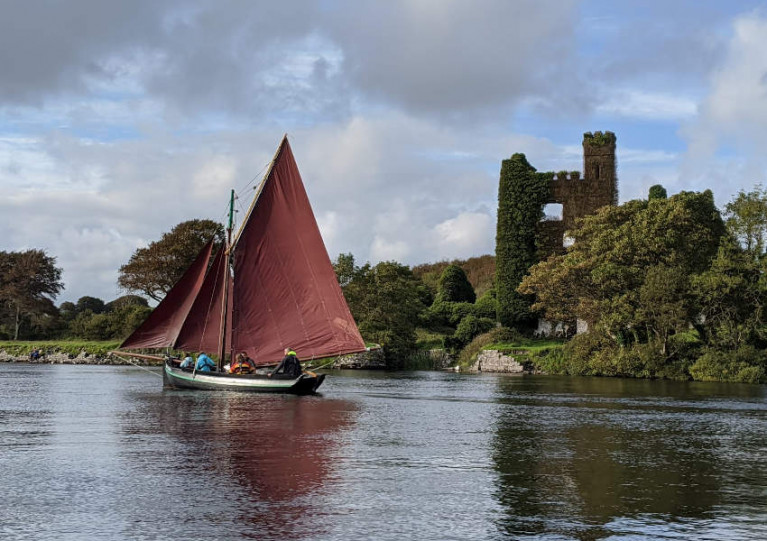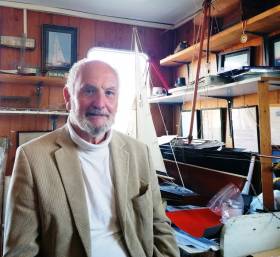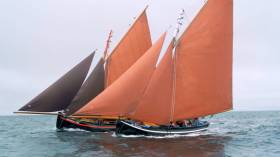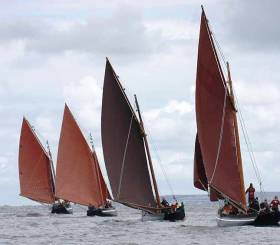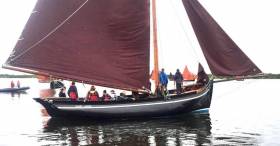Displaying items by tag: Galway Hooker
Dr Mick Brogan is very much at home in the west of Ireland, with his life as a country GP in Mayo neatly balancing his life as a traditional boat sailor, home-ported in Kinvara. In fact, he is so much a man of the west that he becomes restless if he spends any significant time east of the Shannon.
But between the day job and the leisure time interests, there was plenty to keep him occupied along the Atlantic seaboard, and though he had retired from medicine, he was very soon back in harness, re-joining the strength for the battle with COVID-19.
In that capacity, he found his interests over-lapping, as he is Chairman of Cruinniu na mBad in Kinvara. It was way back in early May, when he and his Committee crisply cancelled the mid-August 2020 Gathering of the Boats – always an epic party - that many of us properly realized, for the first time, how anything in sailing that had serious socializing at its core was off the agenda for the foreseeable future.
 Dangerously sociable for pandemic times – communal unloading of the turf at Kinvara after it has been raced in time-honoured style across Galway Bay from Connemara
Dangerously sociable for pandemic times – communal unloading of the turf at Kinvara after it has been raced in time-honoured style across Galway Bay from Connemara
The fate of Cruinniu na mBad 2021 is still in the lap of the Roll-out Gods, though if it does happen it will be August 13th to 15th. But meanwhile, Dublin Bay Old Gaffers Association have signed up Mick Brogan to Zoom talk on Thursday, March 11th about the new life which has been found for the Galway Hookers and other traditional western craft through restoration or re-building projects.
It's a subject in which he has special expertise, as his own vessel, the much-travelled 45ft 6ins Mac Duach, was designed and built on totally traditional lines by Colm Mulkerrins in Connemara in 1979. Originally, she was cutter rigged with an enormous widow-maker of a main boom, but these days she sets a more sedate ketch rig, yet still sails many miles.
 The mighty Mac Duach, built in 1979. Originally she was cutter-rigged, and it was under that rig that Mick Brogan sailed her to the Faroes and many other distant places
The mighty Mac Duach, built in 1979. Originally she was cutter-rigged, and it was under that rig that Mick Brogan sailed her to the Faroes and many other distant places
Mick Brogan's talk at 200hrs on Thursday, March 11th will to some extent following on from Dennis Aylmer's talk on his acquisition of the Galway Hooker Morning Star in 1966. Mick for his part will chart the early revival of interest in the Galway Hooker during the 1970s and 1980s, following its decline during the previous seventy years.
By the 1960s, there no hookers working under sail north of Slyne Head. The Saint John, Inishbofin's mailboat, was under engine. The "Westport" hookers of Achill and Clew Bay were no more. In south Connemara, lorries and improved roads had replaced hookers after WW2.
Ten years later, the introduction of bottled gas and electricity to Aran was killing the turf trade. Hookers were going the way of the horse and cart, but despite all the odds, a revival of interest in the hooker took place. Mick will describe this revival, identify the factors that caused it, and provide details of the people and the hookers involved.
 The spirit of the west – a rejuvenated Connemara Hooker making good speed to Kinvara against the distinctive background of The Burren
The spirit of the west – a rejuvenated Connemara Hooker making good speed to Kinvara against the distinctive background of The Burren
DBOGA Fundraising for HOWTH RNLI: Pre-Covid, DBOGA listened to talks together at Poolbeg while passing the RNLI Yellow Welly around for the €5 donation. In Zoom Land, they can't do that but the RNLI needs funds. Please click here
DBOGA have so far collected €2,399 against their target of €4,000.
The details of this Zoom meeting are:
- Topic: Mick Brogan Talk
- Time: March 11th 2021 at 20.00hrs
- Link to join the meeting: https://us02web.zoom.us/j/87256537027
- Meeting ID: 872 5653 7027
- Passcode: 704478
Traditional Boats Come Centre Stage as Galway 2020 Draws to a Close
Although the much-anticipated Galway 2020 Festival was one of the many aspects of 2020 which has been severely curtailed by the pandemic, the spirit of the great western city and its maritime traditions lives vibrantly on.
A recent ceremony in the Claddagh Basin enabled Peter Connolly of Badoiri na Gallimh to formally thank Galway 2020 and Galway Crystal for their support in a continuing restoration programme which included - in early July - the formal taking-over of the Clondalkin-built bad mor Naomh Cronan, transferred to Galway in excellent order for the princely sum of €1 after 15 years of serving the sailors of the “Clondalkin Gaeltacht” in Dublin.
Irish Sailing Welcomes Galway Hookers Into The Fold
Irish Sailing has welcomed its newest affiliate in the shape of the Galway Hooker Sailing Club.
The club was formed in 2017 when a group of friends came together to revive and retain the Galway Hooker tradition in Galway.
The Galway Hooker is a traditional fishing vessel, built and designed in Galway, and originally dates from the mid 19th century. Their typical red sails are widely seen in logos and brands around the city.
Current club commodore Ciaran Oliver is one of the founding members and together with a current crew of about 100 people has built a steadily growing club with strong links to the local community — particularly through teaching people the skills to sail these iconic vessels.
To learn more, follow the Galway Hooker Sailing Club on Facebook and Instagram or visit their website at GalwayHooker2020.org
The Dublin Bay Old Gaffers Association invites traditional boat enthusiasts and all sailing fans to join their next Zoom session on The First Rescue of the Morning Star, which will be given by former DBOGA President Dennis Aylmer of Dun Laoghaire on Thursday 18th June.
The Morning Star was a bád mór – the largest type of Galway Hooker - built circa 1890, and Dennis was one of the first people to restore a boat of this type and size. In his talk. He will outline the extraordinary tale of how he located and obtained the Morning Star in 1965, and managed the extensive restoration works involved.
This was made all the more interesting by the fact that he lived and worked in Dublin, the Morning Star was in Connemara, and he had no means of transport other than his bicycle……Connemara more than a half-a-century ago was a very different place to what it is now and what Dublin was then, and Dennis weaves that social history aspect into this talk.
Also covered is the eventful passage of the Morning Star to Dublin, down the west coast and through the Grand Canal - all without an engine. The talk is accompanied by the many photos that Dennis took during that period.
The session will start at 19:30 but you are requested to join the Zoom meeting at 19:00 for general chat before the Q&A session. Joining early will also ensure that any connection issues can be sorted out well before 19:30.
The details of this Zoom meeting are:
- Topic: Dennis Aylmer - The First Rescue of the Morning Star
- Time: Jun 18, 2020 07:00 PM
- Link to join meeting: https://us02web.zoom.us/j/86509378699
- Meeting ID: 865 0937 8699 This is all the information you need to join the meeting - there will be no additional details required or provided on the day of the meeting. You do not need a password to join the meeting. If you join the Zoom meeting by clicking the link above (https://us02web.zoom.us/j/86509378699) you will not need the Meeting Id - that is only needed if you want to join the meeting though other means.
On the western edge of Europe lies a unique culture that depended and fought with the Atlantic Ocean for thousands of years.
It is the native sailboat, the Galway Hooker, that sustained this poorest of communities, and the new generation of these same families of sailors still sail the coast of Connemara, now racing to be champions.
TG4’s documentary Bádóiri, now in its second series, follows the historic boats as they awaken from the long Connemara winter, only to find new contenders aboard for this season’s Galway Hooker Racing League regattas.
The preparations have started in earnest, and the show will keep up with the sailors as they race each other in the first of the summer’s races.
In series one we saw the family owned boats battle one another for the coveted prize of All-Ireland champions. In this new series, we introduce a new boat and a new family to the fleet.
Young and eager to impress, this new crew from The Truelight become a racing force to be reckoned as all the crews push themselves and their boats to their limit.
This second series also delves deeper into sailing families lives and histories.
An illness to one of the skippers bring the boatmen together where they share their personal stories as well as their hopes and fears from their sailing culture. Towards the end of the series, the racing and rivalry becomes more intense and the waters become treacherous.
Producer and director Donncha Mac Con Iomaire says: “There are few societies in the world where a 200-year-old boat is the epicentre of the same family for two centuries.
“The maritime community of Connemara never underestimates the Atlantic, and the unity of their families cannot afford to succumb to failure at sea. This ancient world that works hard and plays hard is what is still most genuine culture of Ireland.”
Bádóiri returns tonight, Thursday 5 March, at 8pm on TG4.
New 22-Foot Yacht Built in Kilrush & Based on the Galway Hooker
When I walked into Adrian O’Connell’s office in Kilrush Boatyard on the edge of the Shannon Estuary in County Clare, a photograph on the wall caught my attention – a boat sailing at speed, red sails dramatic atop a black hull.
A powerful image of a ‘Half Boat’ – a ‘Leathbád’ in the lexicon of the famous Galway Hookers. The Leathbád has roughly half the carrying capacity of the Bád Mór, the big Hooker.
Adrian built that boat for the Killary Adventure Centre.
 The Leathbád Adrian O'Connell built for Killary Adventure Centre
The Leathbád Adrian O'Connell built for Killary Adventure Centre
“It was very successful, could sleep six, had a self-draining cockpit, was fully decked and a good sea boat, which was sailed by many people, including young sailors learning about boats and how to sail and enjoy being on the water.”
"At the age of 78, Adrian O'Connell is planning to build yachts based on the Galway Hooker design"
At the age of 78 he is planning to build yachts based on the Galway Hooker design.
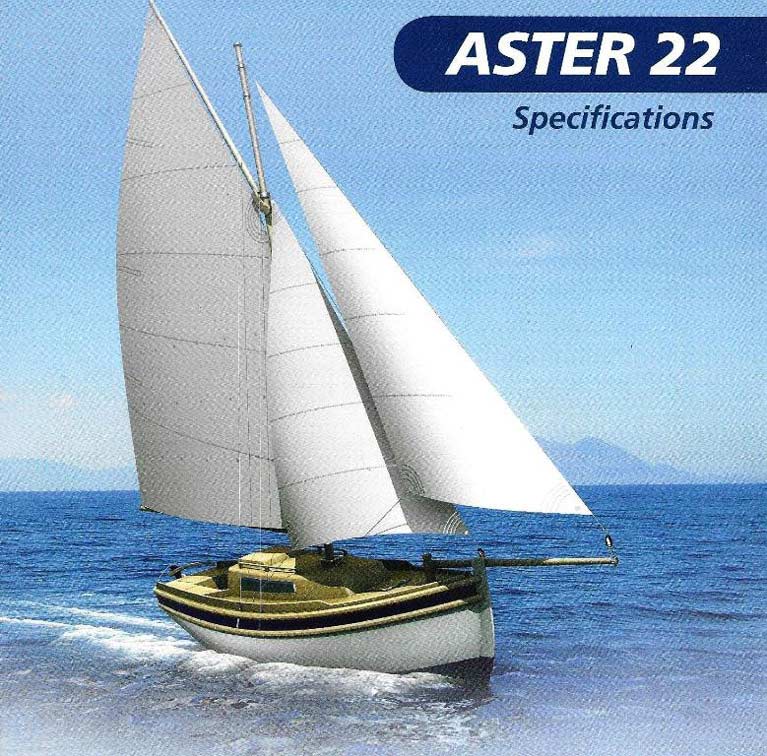 The Aster 22 designed by Adrian O'Connell
The Aster 22 designed by Adrian O'Connell
From a boatyard at Clifden in County Galway where he built fishing boats and the closure of which he blames on the government decision to enter the EU and ”give away the fishing industry,” to Aster Yachts which he now leads as Managing Director is an interesting story, which he told me - after I asked him about that photo of the ‘Leathbád.’
Listen to the Podcast below
Kinvara Rises Above the Weather for Fortieth Cruinniu na mBad
When the late Tony Moylan cajoled the notion of Cruinnui na mBad at Kinvara into being in 1979, times were different writes W M Nixon. The idea was to celebrate the Gathering of the Boats in the old days, when the traditional boats of Connemara on the great inlet’s northwest shore sailed up Galway Bay as Autumn approached well laden with turf, one of the few commodities in which their area was naturally richer than the prosperous region around the southeast corner of the handsome bay.
This year, they celebrated the memory of Tony Moylan in the best possible way, by making Cruinniu na mBad bigger and better and more varied than ever for its Fortieth Anniversary. And though the weather was less than co-operative with a seemingly endless deluge on Saturday, for the big day – Sunday – conditions gradually relented, and Kinvara came colourfully to life in evening sunshine after the ancient craft with their black or tanned sails had experienced good racing.
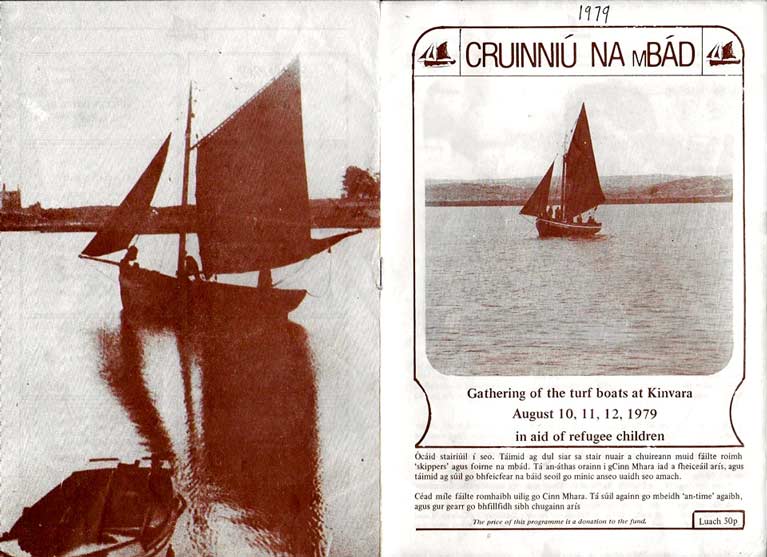 Simpler times. Front and back cover of the booklet for the first Cruinniu na mBad in 1979
Simpler times. Front and back cover of the booklet for the first Cruinniu na mBad in 1979
Cruinniu na mBad is all about the dynamic interaction between sea and land along Ireland’s Atlantic seaboard, and though the conditions on Saturday saw the emphasis inevitably falling on the landward part of the equation – and the indoor aspect of the landward part at that – there were enough musicians and singers and declaimers of poetry and ancient tales in town to keep the show in the road, even if rain came down extremely heavily with impartial force on both the largest thatched roof in all Ireland – it shelters the Merriman Hotel – and roofs of more prosaic style.
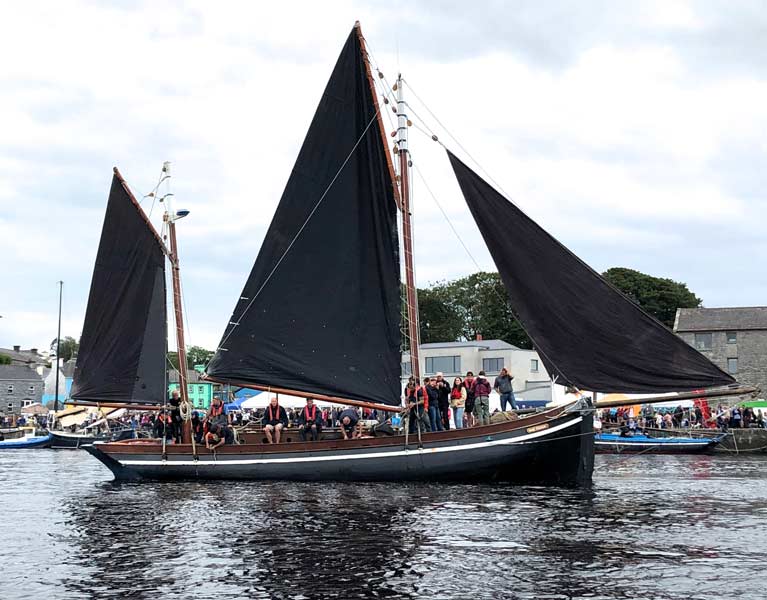 A Committee Boat with a difference – Dr Mick Brogan’s Mac Duach is one of the largest Galway hookers ever built, and though originally a cutter, she has continued her extensive cruising in recent years under ketch rig. Photo: Pierce Purcell
A Committee Boat with a difference – Dr Mick Brogan’s Mac Duach is one of the largest Galway hookers ever built, and though originally a cutter, she has continued her extensive cruising in recent years under ketch rig. Photo: Pierce Purcell
Back in 1979, the digging of turf by hand in the bogs of south Connemara, and then sailing it all the way up the bay, must have seemed one of the most natural and ecologically-sound re-livings of the past you could possibly imagine. But in this hyper-sensitive era, even the burning of humble turf is under scrutiny as a possible menace to our fragile planet, as is the digging of bogs. In the case of Kinvara, it’s something which poses a quandary, for the turf is cut by hand, piled to dry by hand, then moved to be laden by hand onto boats which are sailed by hand – and every bit of it is very hard work if you want to see it as work in the first place.
It’s shared work in a continuum from the land to the sea and back to the land again, and it is nature’s abundant wind which provides the motive power. So anyone who would wish to discourage the Kinvara experience from the turf-burning point of view needs to get a sense of proportion – after all, the Festival itself was promoting the plastic-free ideal as one of its main themes. But in any case we’re talking of turf amounts which are symbolic rather than of significant size, and we’re thinking that the meaning which this annual combination of actions and activities afloat and ashore gives to those involved is something very deep-rooted indeed, an eloquent expression of community.
 Naomh Cailin, skippered by Pat Folan, comes to the mark in style. She finished second overall in the Bad Mhora class. Photo: Pierce Purcell
Naomh Cailin, skippered by Pat Folan, comes to the mark in style. She finished second overall in the Bad Mhora class. Photo: Pierce Purcell
Certainly it’s something which folk from elsewhere wish to share, bringing in crews and boats of other types from places beyond the sea, interesting boats like the comely Sally O’Keeffe from Querrin on the shores of the Shannon Estuary, a very attractive 25ft community-built cutter which is an authentic re-creation of the sailing working boats which used to ply the waters of the mighty Shannon Estuary.
 The Sally OKeeffee had sailed round to Kinvara from the Shannon Estuary – on board are Fintan Ryan, Steve Morris and Dixie Collins. Photo: Pierce Purcell
The Sally OKeeffee had sailed round to Kinvara from the Shannon Estuary – on board are Fintan Ryan, Steve Morris and Dixie Collins. Photo: Pierce Purcell Galway Hooker Association Honorary Secretary Padraic de Bhaldraith at the helm of his gaff cutter Mrs Mouse, hewn from traditional glassfibre…..Photo: Pierce Purcell
Galway Hooker Association Honorary Secretary Padraic de Bhaldraith at the helm of his gaff cutter Mrs Mouse, hewn from traditional glassfibre…..Photo: Pierce Purcell
Also there was the hefty ketch Celtic Mist, research vessel of the Irish Whale & Dolphin Group whose CEO Simon Berrow was on hand with a group of fellow-enthusiasts to spread the message and answer queries while SAR helicopters buzzed overhead and the Galway Lifeboat – crew and boat alike – were keenly represented for the two main days, and talked afterwards of the marvellous sense of community in Kinvara.
 The Irish Whale & Dolphin Group’s much-travelled research vessel Celtic Mist was in Kinvara to spread the word
The Irish Whale & Dolphin Group’s much-travelled research vessel Celtic Mist was in Kinvara to spread the word Marieke Huysman’s music-centre Freedom 40 ketch is a Gary Hoyt design. Her piano is set up on the after deck. Photo: Pierce Purcell
Marieke Huysman’s music-centre Freedom 40 ketch is a Gary Hoyt design. Her piano is set up on the after deck. Photo: Pierce Purcell
Meanwhile, a completely different yet equally appropriate aspect of seafaring was being provided by sea-musician Marieke Huysmans of PianOcean, whose piano was set up on the deck of her Freedom 40 type ketch, which aptly is called Freedom
But inevitably and rightly the attention is mainly on the hookers, which vary in sizes between at least four classes – some would say six – while no two boats are identical, for individuality is the default setting of the west. Presiding over all this was the empress of them all, Organising Committee Chairman Dr Mick Brogan”s giant hooker Mac Duach, which was originally built as a cutter, but at that size her main boom was such a widow-maker that in due course the good doctor made her a more manageable ketch, under which rig she has continued a busy programme of ocean and coastal voyaging and attending western maritime festivals.
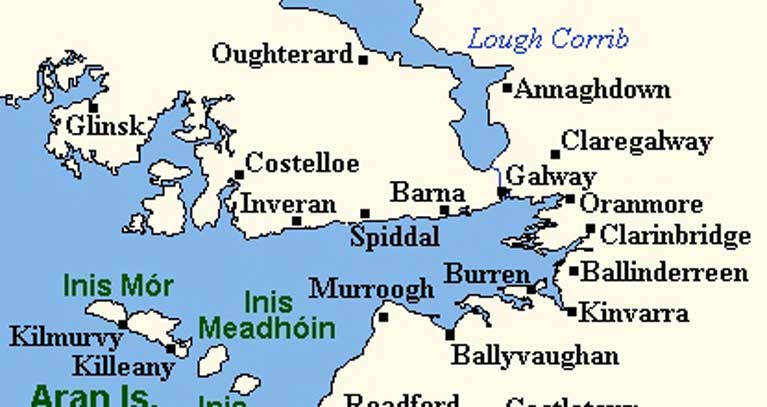 A time-honoured sea trail. The turf is traditionally sailed up Galway Bay from small harbours in the rugged Glinsk region (top left) to the relatively gentle and very sheltered harbour of Kinvara (bottom right)
A time-honoured sea trail. The turf is traditionally sailed up Galway Bay from small harbours in the rugged Glinsk region (top left) to the relatively gentle and very sheltered harbour of Kinvara (bottom right)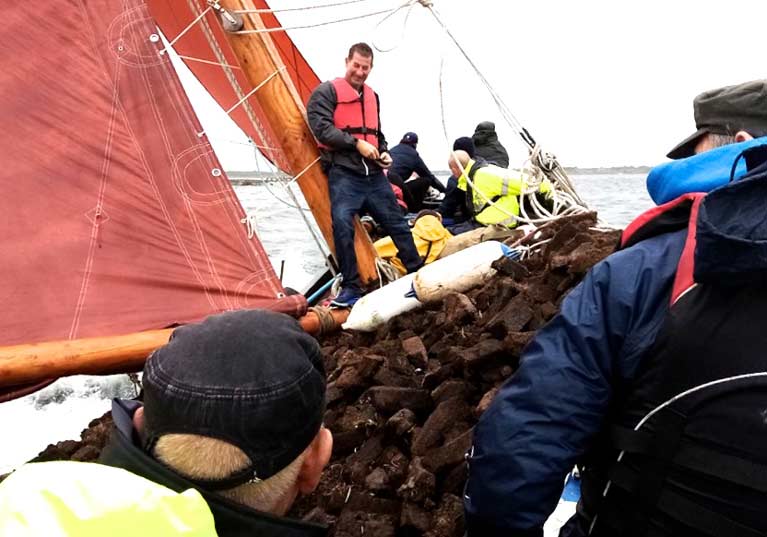 Very little room for the crew……An Mhaighdean Mhara is generously laden with turf as she makes speed from Connemara towards Kinvara. Photo: Iris Aniar
Very little room for the crew……An Mhaighdean Mhara is generously laden with turf as she makes speed from Connemara towards Kinvara. Photo: Iris Aniar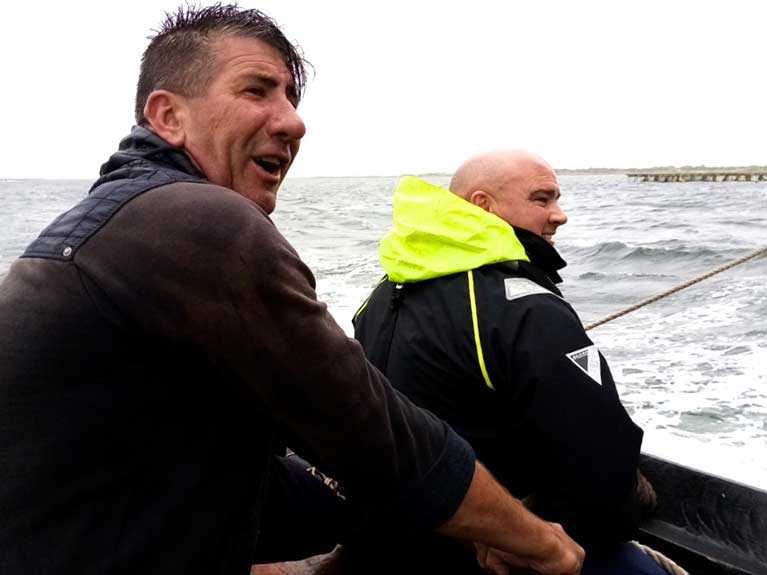 Hard-driving men – Jimmy Mac Donncha and Colm Ciaran O Flatharta getting the knots out of the turf-laden Mhaighdean Mhara as they approach Kinvara. Photo: Iris Aniar
Hard-driving men – Jimmy Mac Donncha and Colm Ciaran O Flatharta getting the knots out of the turf-laden Mhaighdean Mhara as they approach Kinvara. Photo: Iris Aniar Safely in – An Mhaighdean Mhara has glided safely in to Kinvara pier, and the unloading of the cargo is under way. Photo: Iris Aniar
Safely in – An Mhaighdean Mhara has glided safely in to Kinvara pier, and the unloading of the cargo is under way. Photo: Iris Aniar
The main player in the symbolic bringing in of the turf was the mighty An Mhaighdean Mhara, built by McDonagh of Callahaigue in Connemara a very long time ago, re-built or partially re-built now and again since - as is the way of the west - and sailed with considerable style to Kinvara by Jimmy Mac Donncha aided by Colm Ciaran O Flatharta, and laden with such a pile of turf in what is usually the cockpit that the rest of the crew were finding what comfort they could on the foredeck as An Mhaighden Mhara shaped her course into Kinvara’s long natural harbour, gliding alongside the quay to begin the long and sweaty job of discharging the cargo by hand.
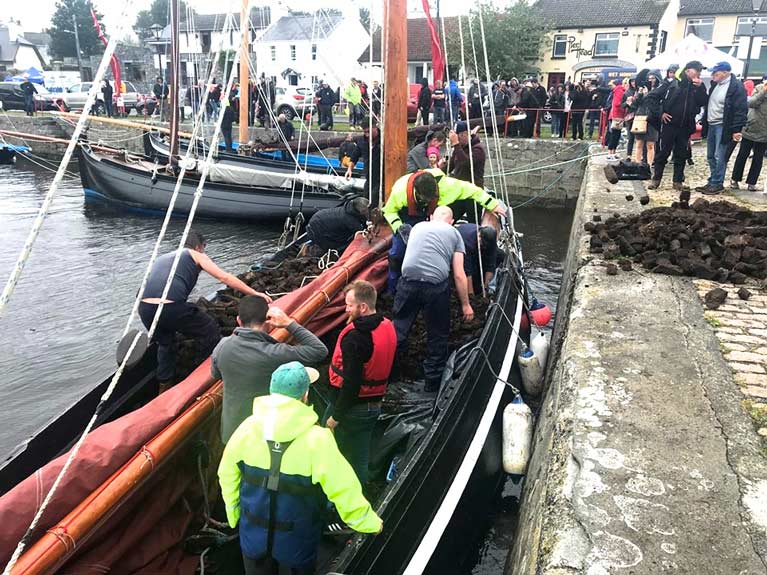 Not a job for the faint-hearted – all of An Mhaighdean Mhara’s cargo was to be unloaded by hand……..Photo: Iris Aniar
Not a job for the faint-hearted – all of An Mhaighdean Mhara’s cargo was to be unloaded by hand……..Photo: Iris Aniar
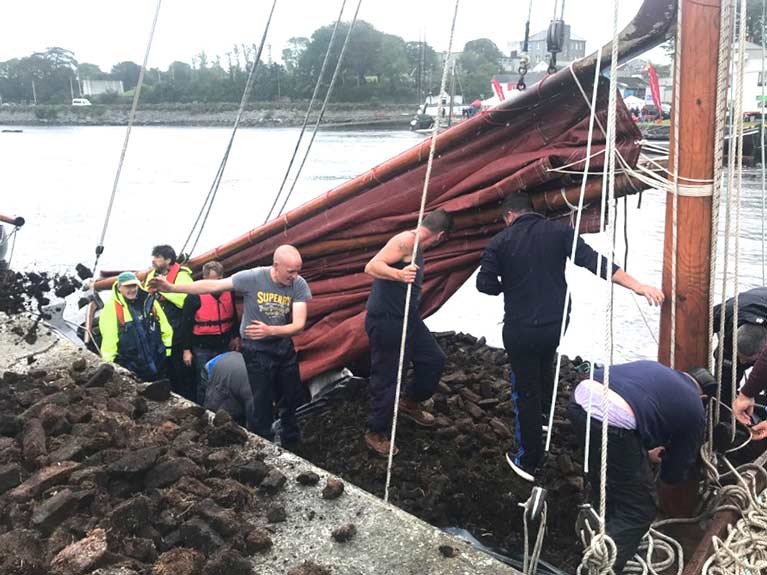 The rhythm of unloading is gathering speed and co-ordination. Photo: Iris Aniar
The rhythm of unloading is gathering speed and co-ordination. Photo: Iris Aniar
With the many and varied rituals completed or at least set in train, Sunday brought the racing, as hard fought as ever. As anyone who has ever tried to report on Galway hooker racing - whether at Kinvara or one of the traditional events in Connemara itself – there will be as many different versions of what happened during the race as there are people involved, for at times it cannot even be agreed within crews as to what happened or didn’t. Yet when they’re eventually published, there’s a finality about results which sets the story to rest, and we can do no more than publish them as they were – in due course – supplied to us.
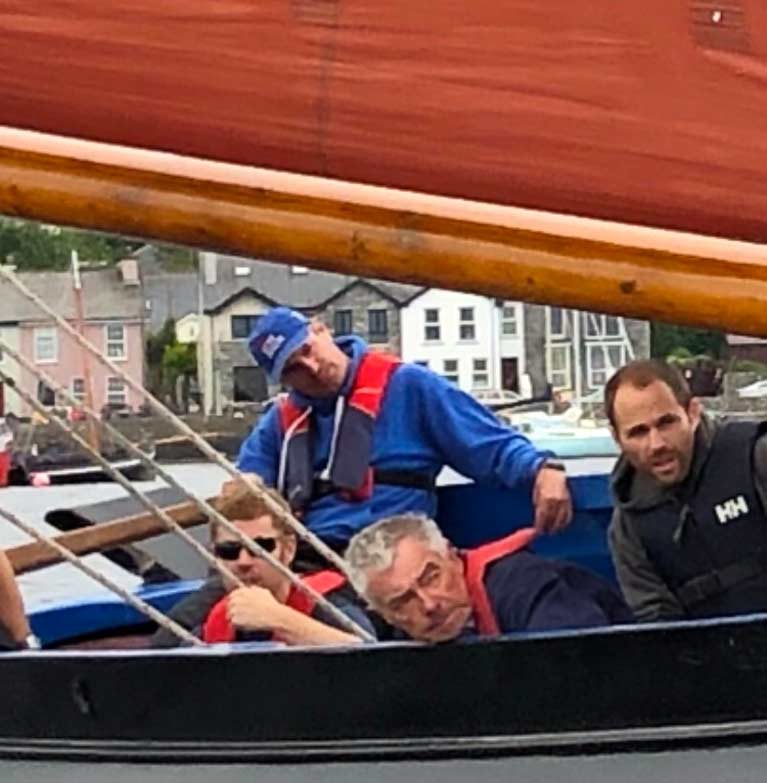 Pre-start tension. Defending champion in the Bad Mhora class An Tonai shaping in for the line, with Captain-General Mairtin O’Brian sizing up the situation with his chin on the rail, while Skipper Ronan O'Brien looks to the helming. Their defence of the title was successful. Photo: Pierce Purcell
Pre-start tension. Defending champion in the Bad Mhora class An Tonai shaping in for the line, with Captain-General Mairtin O’Brian sizing up the situation with his chin on the rail, while Skipper Ronan O'Brien looks to the helming. Their defence of the title was successful. Photo: Pierce Purcell
Cruinniu na mBad 2019 Results:
Bad Mhora: 1st Tonai, skippered by Ronan O’Brien; 2nd Cailin, sk. Pat Folan; 3rd An Mhaghdean Mhara, sk. Jimmy Mac Donncha
Leath-Bhaid: 1st Norah, sk. Sean Mac Donncha; 2nd Colmcille, sk. Mairtin Thornton; 3rd Antain, sk. Joe Reaney
Gleiteog Mor: 1st Catherine, sk. Paraic Barrett; 2nd Ciarain, sk. John Flaherty; 3rd An Bhantra, sk. Daragh O Tuairisc
Gleiteog Beag: 1st Erin’s Hope, sk. Pat Folan; 2nd Sianach, sk. Ciaran Mac Donncha, 3rd Nora Bheag, sk. Coilin Og Hernon.
The sport over, the sun appeared - and Kinvara partied.
 Finally, a bit of evening sunshine to round out the day. Photo: Pierce Purcell
Finally, a bit of evening sunshine to round out the day. Photo: Pierce Purcell
#OnTV - A new four-part documentary series on the people of Ireland’s west who keep the Galway Hooker sailing tradition alive behind tomorrow night (Thursday 10 January) at 8pm on TG4.
Bádóirí provides an insight into seven Connemara families, part of one of the few indigenous communities of sailors left in Europe, as they compete to be champions of the Galway Hooker Association Racing League.
The first of four episodes screens tomorrow at 8pm and will be available to stream for viewers in Ireland on the TG4 Player.
Galway Hooker Chairman Calls For Support for ‘Special Boats’
The Chairman of the Galway Hookers Association says that these iconic boats deserve support to ensure their future as part of Ireland’s maritime heritage.
Dr.Michael Brogan told me in an interview which you can hear on this week’s Podcast (below): “The Galway Hooker is the iconic emblem of so many things about Galway and Connemara, which is used in every logo around Galway, but though many use it they don’t give anything back to it. We should not take these boats for granted. They are part of our heritage, they are an art form in themselves, the traditional sailing craft of Ireland, of the West, of Connemara and these craft should be given a similar recognition, for example say like the artists in Aosdána. I think they should be given a similar type of grant for their artistic work in keeping up the boats, just to help buying paint, anti-fouling, putting in new planks, things like that.”
He is hoping to get together “a group of interested people and put some pressure on the appropriate authorities and highlight to all those who use, admire and benefit from the Galway Hooker as an ionic emblem to ensure that the people who maintain, who keep these great boats going get some type of stipend and support.”
“These iconic boats deserve to be considered as part of the traditional art form of Ireland, which they are in the maritime sense and it is time to recognise that.”
I talked to Michael Brogan at Cruinniu na mBád, the Gathering of the Boats, in Kinvara, Co.Galway. Listen to him on this week’s Podcast below, where he starts by telling me how he bought the Galway Hooker, Mac Duach, the biggest of the fleet and I recall that I once helmed it and found just how strong these boats are.
Colie Hernon and his family were setting the competitive pace over the weekend at the Crinniu na mBad in Kinvara, with the man himself winning the leath bad race with the 2012-built Croi an Cladaig, while his son Colie og Hernon was winner in the gleotogs with Nora Bheag writes W M Nixon.
The very handsome Croi an Cladaig featured here last week when we were previewing the annual festival, which in its modern form was founded by Tony Moylan in 1979 as a celebration of the western maritime and folk traditions.
 Croi an Cladaigh sailing in the kind of weather everyone had hoped for at the weekend, but it didn’t arrive. The superb sails were made in the west by Dara Baily.
Croi an Cladaigh sailing in the kind of weather everyone had hoped for at the weekend, but it didn’t arrive. The superb sails were made in the west by Dara Baily.
The sunlit image of Croi an Cladaig was so cheering that we were moved to put the most favourable possible spin on the weather predictions. That inspiring mainsail, by the way, was made in Connemara by Dara Bailey. But as our photos from the Pierces Purcell, father and son, clearly indicate, far from a brisk and sunny westerly, a huge crowd and a large fleet had to make do with rain and a fitful sou’east breeze.
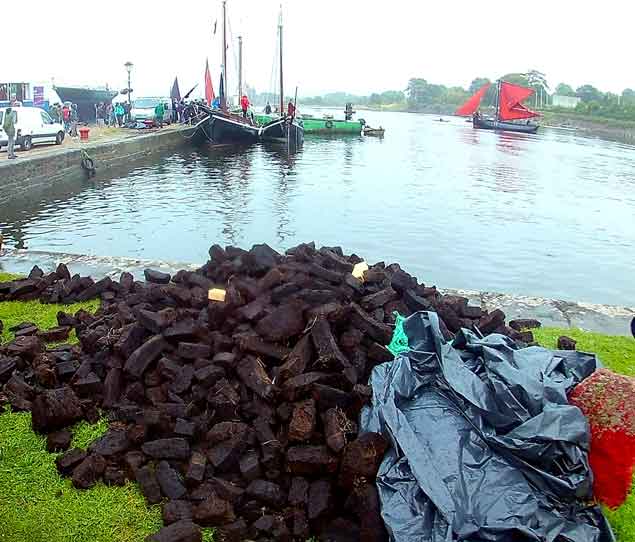 Part of the tradition is the delivery by hookers of the Connemara turf
Part of the tradition is the delivery by hookers of the Connemara turf
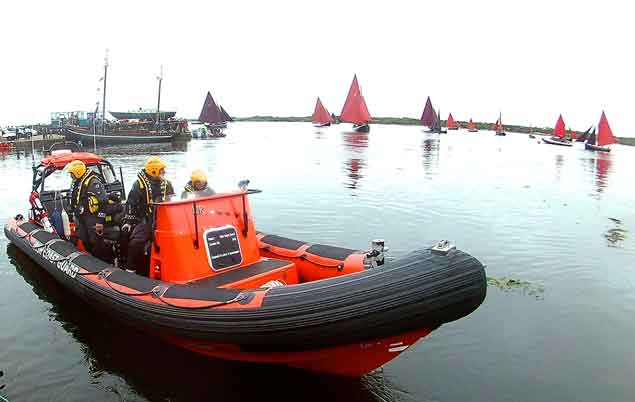 The Coastguard Service plays a key role in Galway Bay, and the local division were welcome guests at Kinvara
The Coastguard Service plays a key role in Galway Bay, and the local division were welcome guests at Kinvara
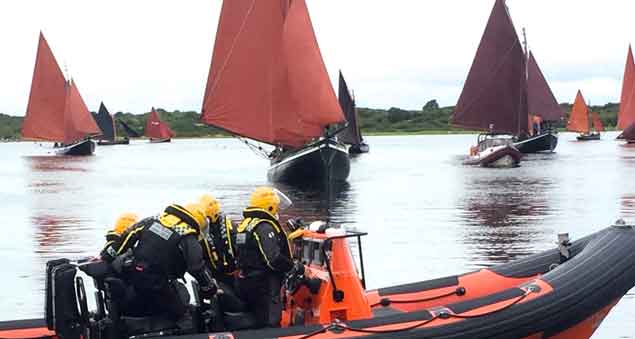 ….and they were able to get the best view of a slow-moving but fascinating race Yet the boats were so interesting and the onshore entertainments and food & drink experiences so many and varied that some who were there claim they didn’t notice any rain at all. Under the benign direction of Dr Michael Brogan it all went swimmingly, deliberately so in the case of those who took part in the time-honoured cross-harbour swim, and preferably not swimming at all for those who were in the in the seaweed boat race – don’t ask, the photo says it all.
….and they were able to get the best view of a slow-moving but fascinating race Yet the boats were so interesting and the onshore entertainments and food & drink experiences so many and varied that some who were there claim they didn’t notice any rain at all. Under the benign direction of Dr Michael Brogan it all went swimmingly, deliberately so in the case of those who took part in the time-honoured cross-harbour swim, and preferably not swimming at all for those who were in the in the seaweed boat race – don’t ask, the photo says it all.
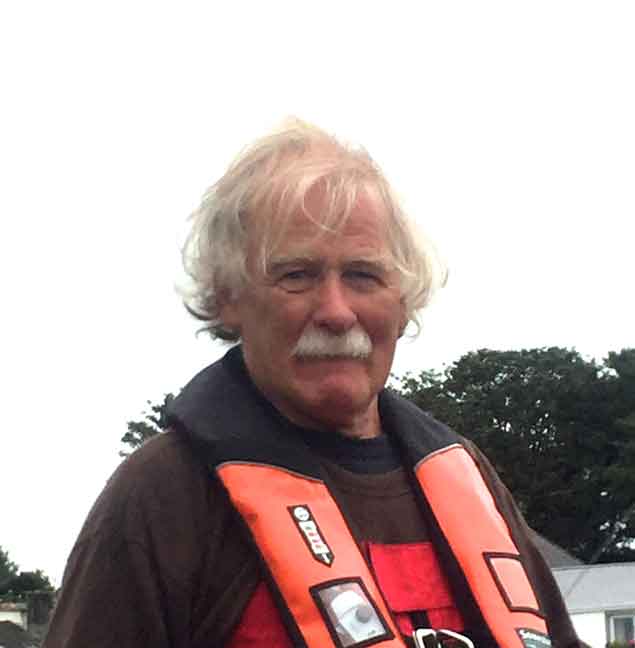 Dr Michael Brogan was the benign director of events
Dr Michael Brogan was the benign director of events
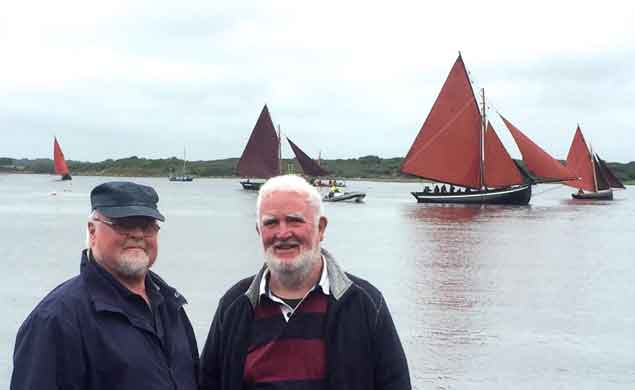 Men of the west – Pierce Purcell of Galway and Arctic voyager Jarlath Cunnane of Mayo at Kinvara
Men of the west – Pierce Purcell of Galway and Arctic voyager Jarlath Cunnane of Mayo at Kinvara
 “Rather you than me” – the traditional cross-harbour swimming race has some adhererents who have been involved from the start of the modern festival
“Rather you than me” – the traditional cross-harbour swimming race has some adhererents who have been involved from the start of the modern festival
 We don’t know if it’s a boat filled with seaweed, or a seaweed boat, but it definitely happens at Kinvara, and they race them
We don’t know if it’s a boat filled with seaweed, or a seaweed boat, but it definitely happens at Kinvara, and they race them
The requisite cargoes of traditional turf were on the Kinvara quayside from Connemara, and the inevitably slow racing began. The rest of the world thinks it is getting to grips with the nomenclature of Galway Bay’s traditional boats, but then those in the heart of it all move the goal-posts with a new category which we hadn’t heard of before, but doubtless it has been around since the time of St Brendan.
This is the gleotog mor, the “big gleotog”, which one expert assured us is somewhere between a leath bad and a bad mor. Thus in order of size we presumably ascend from the pucaun through the gleotog, the leath bad, the gleotog mor, and the bad mor which can go on to become something enormous like the Chicago-built, Atlantic-crossing Naomh Bairbre.
But exact categorization depends on so many factors that it’s not a topic for the faint-hearted, let alone the dim-witted, in which category we include ourselves when it comes to working out what’s what west of the Shannon.
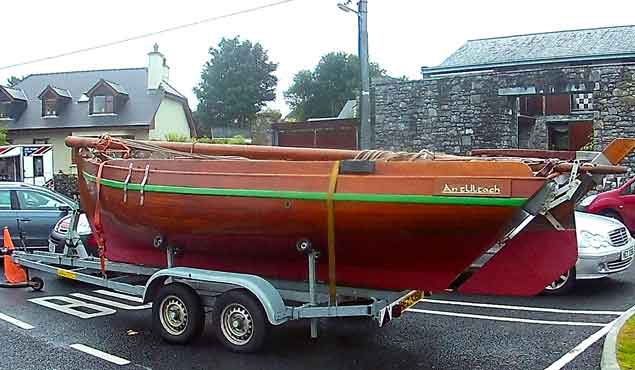 Is it a pucaun? Is it a gleotog? It depends on the size. And the rig. And other things…..This one had been road-trailed from the north. On a sunny day she might look orange, but she looked very brown on Sunday
Is it a pucaun? Is it a gleotog? It depends on the size. And the rig. And other things…..This one had been road-trailed from the north. On a sunny day she might look orange, but she looked very brown on Sunday
All we know is that every size was represented. There was even what looked like a pucaun road-trailed down from the north in a shade of brown through varnish which might look orange on a sunny day, but definitely looked brown in Sunday. And on the harbour in front of everyone was a traditional boat which seemed well on the way to becoming a yacht, for with her immaculate black topsides she sported a very stylish white boot-top at the forefoot to set off the blue anti-fouling.
The visual effect of a neat white boot-top, even a partial one, cannot be over-estimated – the great schooner Atlantic which was in Dun Laoghaire last week absolutely cried out for one, as she didn’t look her best with midnight blue topsides and dark grey anti-fouling with nothing in between.
But there in Kinvara was John Flaherty’s Naomh Cailin looking very well indeed with her white boot-top, and she was more than just good looks – she went out and won this gleotog mor class which is only just registering on our radar, and looked great doing it, with her Philip Watson sails settling in nicely as the breeze got a bit of life to it.
As for the really grown-up class, the bad mor division, that was won by the Tonai, skippered by Mairtin O’Brien. Yet again, the Kinvara gathering leaves us with a cascade of visions of unique boats - and unique people too. May it continue for ever.
 Kinvara’s Crinnui na mBad provides a cascade of visual memories to see everyone through to another year
Kinvara’s Crinnui na mBad provides a cascade of visual memories to see everyone through to another year




























